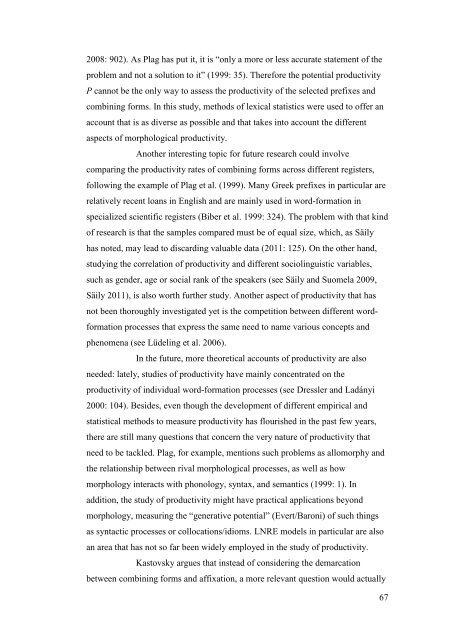The morphological productivity of selected ... - Helda - Helsinki.fi
The morphological productivity of selected ... - Helda - Helsinki.fi
The morphological productivity of selected ... - Helda - Helsinki.fi
You also want an ePaper? Increase the reach of your titles
YUMPU automatically turns print PDFs into web optimized ePapers that Google loves.
2008: 902). As Plag has put it, it is “only a more or less accurate statement <strong>of</strong> the<br />
problem and not a solution to it” (1999: 35). <strong>The</strong>refore the potential <strong>productivity</strong><br />
P cannot be the only way to assess the <strong>productivity</strong> <strong>of</strong> the <strong>selected</strong> pre<strong>fi</strong>xes and<br />
combining forms. In this study, methods <strong>of</strong> lexical statistics were used to <strong>of</strong>fer an<br />
account that is as diverse as possible and that takes into account the different<br />
aspects <strong>of</strong> <strong>morphological</strong> <strong>productivity</strong>.<br />
Another interesting topic for future research could involve<br />
comparing the <strong>productivity</strong> rates <strong>of</strong> combining forms across different registers,<br />
following the example <strong>of</strong> Plag et al. (1999). Many Greek pre<strong>fi</strong>xes in particular are<br />
relatively recent loans in English and are mainly used in word-formation in<br />
specialized scienti<strong>fi</strong>c registers (Biber et al. 1999: 324). <strong>The</strong> problem with that kind<br />
<strong>of</strong> research is that the samples compared must be <strong>of</strong> equal size, which, as Säily<br />
has noted, may lead to discarding valuable data (2011: 125). On the other hand,<br />
studying the correlation <strong>of</strong> <strong>productivity</strong> and different sociolinguistic variables,<br />
such as gender, age or social rank <strong>of</strong> the speakers (see Säily and Suomela 2009,<br />
Säily 2011), is also worth further study. Another aspect <strong>of</strong> <strong>productivity</strong> that has<br />
not been thoroughly investigated yet is the competition between different wordformation<br />
processes that express the same need to name various concepts and<br />
phenomena (see Lüdeling et al. 2006).<br />
In the future, more theoretical accounts <strong>of</strong> <strong>productivity</strong> are also<br />
needed: lately, studies <strong>of</strong> <strong>productivity</strong> have mainly concentrated on the<br />
<strong>productivity</strong> <strong>of</strong> individual word-formation processes (see Dressler and Ladányi<br />
2000: 104). Besides, even though the development <strong>of</strong> different empirical and<br />
statistical methods to measure <strong>productivity</strong> has flourished in the past few years,<br />
there are still many questions that concern the very nature <strong>of</strong> <strong>productivity</strong> that<br />
need to be tackled. Plag, for example, mentions such problems as allomorphy and<br />
the relationship between rival <strong>morphological</strong> processes, as well as how<br />
morphology interacts with phonology, syntax, and semantics (1999: 1). In<br />
addition, the study <strong>of</strong> <strong>productivity</strong> might have practical applications beyond<br />
morphology, measuring the “generative potential” (Evert/Baroni) <strong>of</strong> such things<br />
as syntactic processes or collocations/idioms. LNRE models in particular are also<br />
an area that has not so far been widely employed in the study <strong>of</strong> <strong>productivity</strong>.<br />
Kastovsky argues that instead <strong>of</strong> considering the demarcation<br />
between combining forms and af<strong>fi</strong>xation, a more relevant question would actually<br />
67
















